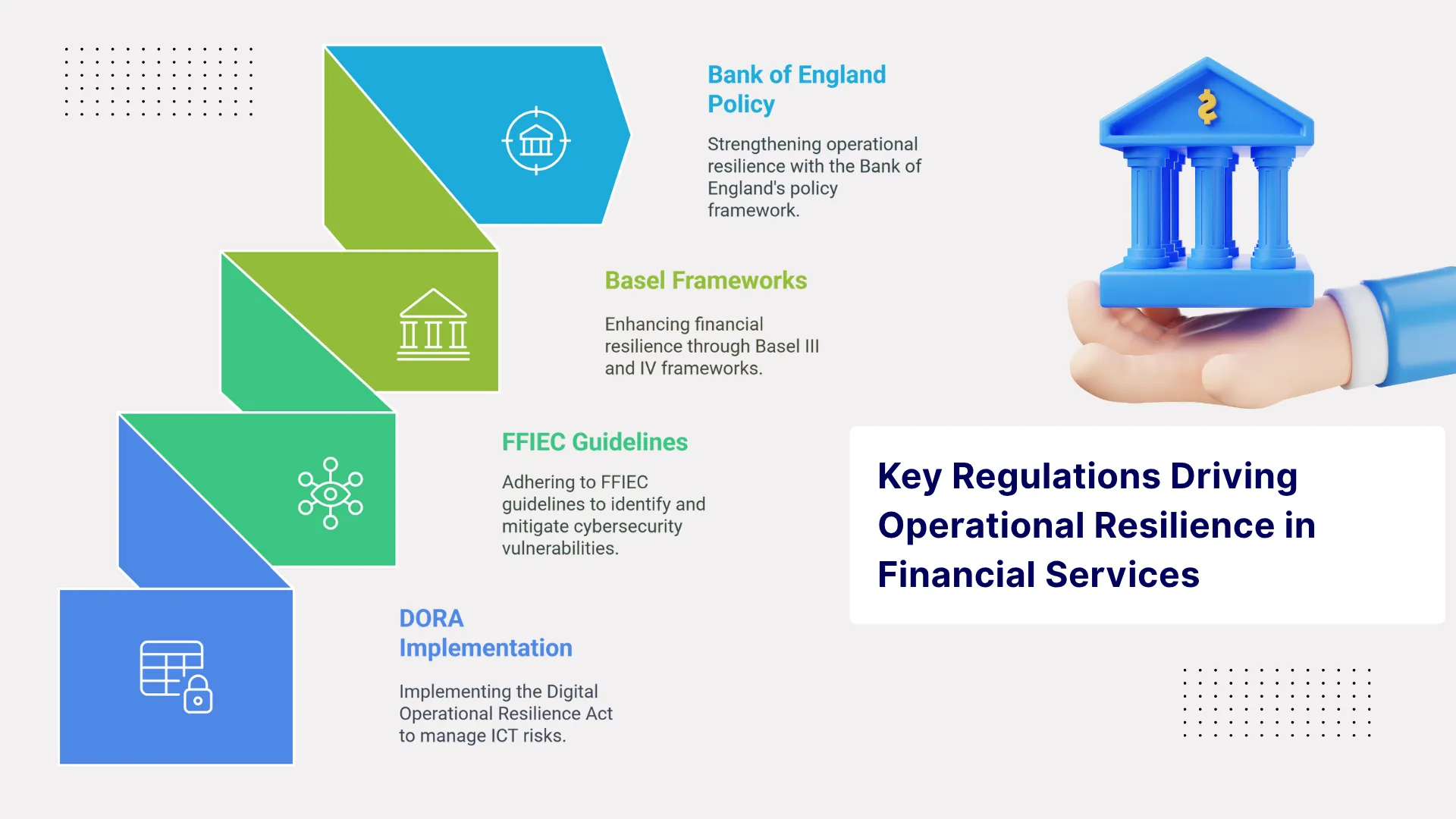
Home » Building Operational Resilience: Automation’s Role in Meeting Regulatory Demands

Financial institutions have long operated under pressure from strict regulatory frameworks. Requirements such as strong security, operational resilience, and real-time processing have forced banks to constantly adapt.
As regulatory bodies grow more stringent and demand rapid compliance shifts, manual methods no longer provide adequate response. To keep pace, banks must adopt automated regulatory compliance systems that deliver a smarter, faster way to meet their obligations.
By implementing compliance automation software, organizations can streamline complex regulatory workflows and ensure alignment with global standards. In this blog, we’ll explore how automation is helping banks build operational resilience with active compliance to regulations.

Regulatory authorities enforce a range of laws to protect financial institutions from operational disruptions even during events like cyberattacks, infrastructure failures, or disasters. Below are some global key regulations that ensure operational excellence:
The Digital Operational Resilience Act (DORA) is a European Union regulation that strengthens the digital operational resilience of financial entities. It focuses on effectively managing risks related to Information and Communication Technology (ICT).
DORA is structured around five key pillars:
The Federal Financial Institutions Examination Council (FFIEC) provides a foundational set of guidelines in the U.S. to enhance operational resilience in financial institutions.
Through its Cybersecurity Assessment Tool and IT handbooks, the FFIEC helps organizations identify vulnerabilities, monitor evolving threats, and strengthen their capacity to withstand and recover from cyber incidents.
The Basel III and IV frameworks, developed by the Basel Committee on Banking Supervision, enhance financial system resilience through stricter capital, liquidity, and leverage requirements.
They also mandate structured approaches to managing operational risk, including improved risk data aggregation and stress testing capabilities.
The Bank of England, along with the Prudential Regulation Authority (PRA) and Financial Conduct Authority (FCA), introduced a policy framework to strengthen operational resilience in UK financial services.
It requires firms to identify important business services, define impact tolerances, and test their ability to remain within those limits during severe disruptions.
Automated regulatory reporting enables banks to effectively comply with complex evolving regulations. Rather than manually updating compliance logs or generating audit reports, automation combines technologies like AI, RPA, and NLP to manage, monitor, and fulfill regulatory requirements efficiently.
Why banks must replace manual processes with automation:
Get free Consultation and let us know your project idea to turn into an amazing digital product.

In financial institutions, effective operational resilience is driven by continuous risk identification, response coordination, and compliance execution. Automation addresses these functions by integrating decision logic, event detection, and real-time reporting into financial systems.
Automated risk management systems use rule engines, statistical models, and real-time data ingestion to identify and mitigate operational risks. These systems can:
Automated compliance monitoring platforms incorporate APIs, log analytics, and machine learning models to detect violations of regulatory policies as they occur. These systems support:
Automated incident reporting systems structure data flows from detection to disclosure, in line with supervisory timelines. These systems typically include:
Using third-party risk management automation for operational resilience is a strategic move. It unifies vendor performance metrics, SLA breaches, and compliance obligations into a single monitoring environment. Capabilities include:
Automation in operational resilience testing is critical. The advantage of this solution is it simulates operational disruptions across business-critical services. These systems execute:
Regulatory technologies (RegTech) are specifically designed to modernize compliance management in financial institutions. These tools combine AI, RPA, and analytics to replace static, manual compliance frameworks with intelligent, automated models.
An effective regulatory operations automation platform must support scalable compliance execution, ensure regulatory alignment, and reduce manual overhead through intelligent system design. Core features include:
Share your project idea with us. Together, we’ll transform your vision into an exceptional digital product!

1. ING Bank – Automating Regulatory Reporting Under DORA
Use Case: To comply with the European Union’s Digital Operational Resilience Act (DORA), ING implemented a RegTech platform to automate its ICT risk and incident reporting. The solution integrated real-time monitoring of critical systems with incident escalation workflows.
Technology Used: AI-powered risk monitoring, RPA for incident documentation, and APIs to push data into EU-mandated reporting formats.
Impact:
2. HSBC– Automating Third-Party Risk Oversight
Use Case: HSBC rolled out an automated third-party risk management system across its global operations. The goal was to improve operational resilience by proactively managing vendor-related regulatory risks.
Technology Used: AI/ML for continuous vendor risk scoring, smart contract enforcement, and RPA for auto-generating audit logs.
Impact:
Even a minute of service disruption can be a nightmare for financial institutions. With increasing security risks and operational vulnerabilities, manual processes often fall short in identifying and responding to issues quickly.
Automated financial compliance systems not only help banks stay aligned with evolving regulations but also offer powerful capabilities like real-time monitoring and early fraud detection. These features protect institutions from costly disruptions and reputational damage.
Meeting the growing demands of digital availability and regulatory compliance becomes easier when financial institutions embrace automation.
Operational resilience is a bank’s ability to deliver critical operations and services during disruptions like cyberattacks, system failures, or natural disasters. It’s crucial because it protects customers, maintains financial stability, and ensures regulatory compliance while minimizing business impact and reputational damage.
Automation enhances compliance by providing real-time monitoring, automated incident reporting, proactive risk alerts, and faster regulatory submissions. It replaces manual processes with AI-powered systems that can quickly adapt to new regulations, reduce human errors, and provide continuous compliance visibility across all operations.
Automated risk management systems use rule engines, statistical models, and real-time data ingestion to identify and mitigate operational risks. They aggregate risk data from multiple sources, run automated compliance testing, generate threshold-based alerts, and provide continuous risk monitoring across business units and systems.
Real-time compliance monitoring provides continuous evaluation of control effectiveness, automatic alerting for violations, centralized visibility into compliance status, and proactive risk detection. This approach prevents regulatory breaches, reduces manual oversight costs, and enables faster response to emerging compliance issues and regulatory changes.
Success is measured through key metrics including incident response time reduction, compliance reporting accuracy improvements, cost savings percentages, regulatory examination ratings, system uptime improvements, risk detection speed, audit finding reductions, staff productivity gains, and overall operational resilience maturity assessments.
AI enhances compliance monitoring through pattern recognition for fraud detection, anomaly identification in transaction data, predictive analytics for risk assessment, natural language processing for regulatory document analysis, machine learning for adaptive rule engines, and automated decision-making for routine compliance tasks.
Compliance automation leverages AI for pattern recognition and anomaly detection, RPA for process automation and data entry, machine learning for predictive analytics, APIs for system integration, NLP for document processing, and cloud platforms for scalable processing and real-time monitoring capabilities.

Have a one on one discussion with our Expert Panel

Secure access is vital for organizations managing digital identities in today’s landscape. While both CIAM and IAM secure user identities, they serve different purposes — CIAM for customers and IAM for employees. This article explores their key differences and how to choose the right system.

For decades, traditional banking systems handled only basic transactions. The digital era exposed their limitations in speed and adaptability. Evolved core banking now powers seamless, future-ready financial services.

As digital expectations grow, customers now demand speed, ease of use, and 24/7 availability. To meet these demands at scale, digital-only banks choose business process automation in the banking industry to deliver consistent, responsive, and personalized service.

Founder and CEO

Chief Sales Officer
